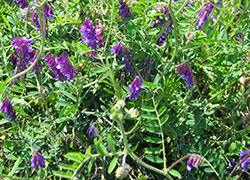Mid-October is a good time to plant winter cover crops for improving soils where vegetables are grown. A long term plan for building and maintaining desirable levels of both organic matter and nitrogen is desirable. Non-legume cover crops help with organic matter and legumes can add both organic matter and nitrogen.
What are good cover crops?
One common cover crop is winter rye but there is a lot of confusion about what that is. Winter rye is cereal rye, Secale cereale, the same rye used for grain. Annual or Italian ryegrass, Lolium multiflorum, can be used as a cover crop in certain circumstances but winterkills in cold, dry Front Range conditions. Annual rye should be sown in early fall. Winter rye is one of the hardiest of cereals and can be seeded later in fall.
When do cover crops grow?
Growth is rapid in cool fall weather and its quick-growing, fibrous roots hold soil and leftover fertilizer well. It is also good at suppressing weeds. Rye can also be sown with legumes in fall.
What is the most popular cover crop?
Hairy vetch, Vicia villosa, is one of the most popular. It is winter hardy to zone 4 and can work in zone 3 with snow cover. It grows slowly but root growth continues over winter and vine growth quickens with arrival of spring. It tolerates poor soils (including sandy ones) and delivers a heavy contribution of nitrogen compliments of its symbiotic nitrogen fixing bacteria.
Are there cover crops that produce peas?
A type of field pea (Pisum sativum subsp. arvense), Austrian winter pea, can also be used as a winter legume. It is not as cold hardy as hairy vetch and should be seeded in early fall. Plant it with a winter grain such as rye to protect pea roots and maximize winter survival. It prospers best with some winter moisture.
When should I plant my cover crop?
A rule of thumb is to plan for at least a month in spring after turning under cover crops to allow them to decompose before planting vegetables.
For more information, see the following Planttalk Colorado™ script(s).



